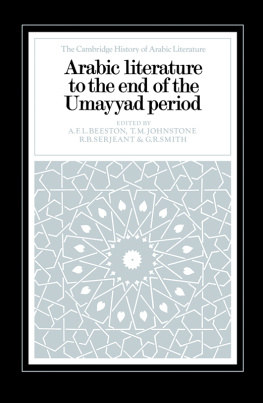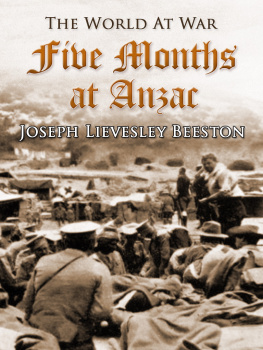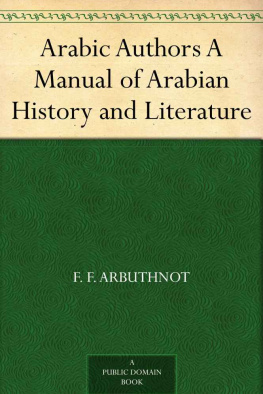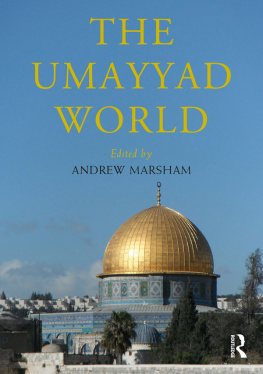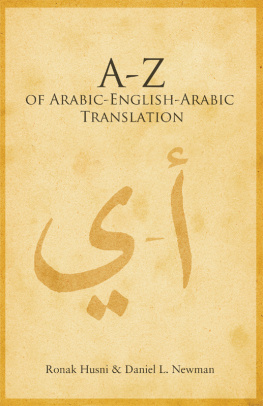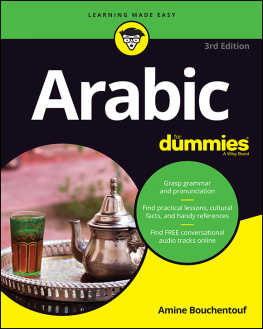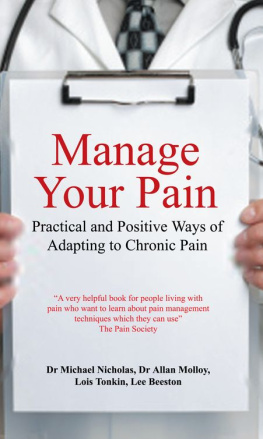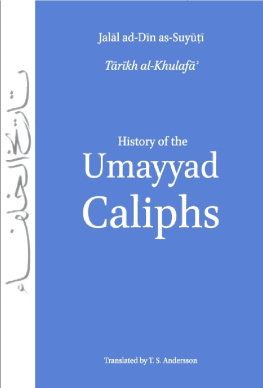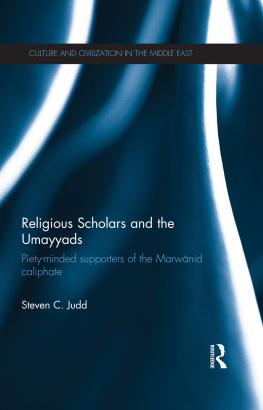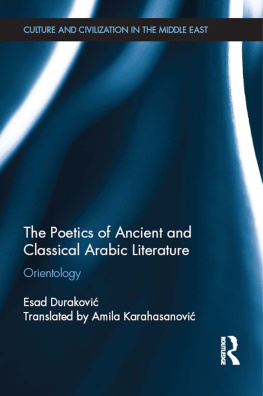Beeston A. F. L. (EDT) - Arabic Literature to the End of the Umayyad Period
Here you can read online Beeston A. F. L. (EDT) - Arabic Literature to the End of the Umayyad Period full text of the book (entire story) in english for free. Download pdf and epub, get meaning, cover and reviews about this ebook. year: 2014, publisher: CambridgeUP, genre: Detective and thriller. Description of the work, (preface) as well as reviews are available. Best literature library LitArk.com created for fans of good reading and offers a wide selection of genres:
Romance novel
Science fiction
Adventure
Detective
Science
History
Home and family
Prose
Art
Politics
Computer
Non-fiction
Religion
Business
Children
Humor
Choose a favorite category and find really read worthwhile books. Enjoy immersion in the world of imagination, feel the emotions of the characters or learn something new for yourself, make an fascinating discovery.
- Book:Arabic Literature to the End of the Umayyad Period
- Author:
- Publisher:CambridgeUP
- Genre:
- Year:2014
- Rating:5 / 5
- Favourites:Add to favourites
- Your mark:
- 100
- 1
- 2
- 3
- 4
- 5
Arabic Literature to the End of the Umayyad Period: summary, description and annotation
We offer to read an annotation, description, summary or preface (depends on what the author of the book "Arabic Literature to the End of the Umayyad Period" wrote himself). If you haven't found the necessary information about the book — write in the comments, we will try to find it.
Arabic Literature to the End of the Umayyad Period — read online for free the complete book (whole text) full work
Below is the text of the book, divided by pages. System saving the place of the last page read, allows you to conveniently read the book "Arabic Literature to the End of the Umayyad Period" online for free, without having to search again every time where you left off. Put a bookmark, and you can go to the page where you finished reading at any time.
Font size:
Interval:
Bookmark:
THE CAMBRIDGE HISTORY OF ARABIC LITERATURE
ARABIC LITERATURE TO THE END OF THE UMAYYAD PERIOD
THE CAMBRIDGE HISTORY OF ARABIC LITERATURE
GENERAL EDITORS
Professor A. F. L. Beeston, Professor T. M. Johnstone, Professor J. D. Latham, Professor R. B. Serjeant, Dr G. R. Smith
ADVISORY EDITORIAL BOARD
Ihsan Abbas American University of Beirut
Mustafa Badawi University of Oxford
S. A. Bonebakker University of California, L.A.
P. Cachia Columbia University
Majid Fakhry American University of Beirut
W. Fischer University of Erlangen-Nrnberg
Abdallah Gannun Academy of Moroccan Scholars, Tangier
Muhsin Mahdi Harvard University
P. Martnez Montavez University of Madrid
Muhammad Yusuf Najm American University of Beirut
C. Pellat Sorbonne University
K. Petraek University of Prague
Sahair el Calamawy Cairo
Abdulla el Tayib Fez
J. van Ess University of Tubingen
E. Wagner JustusLiebig University
ARABIC LITERATURE TO THE END OF THE UMAYYAD PERIOD
EDITED BY
A. F. L. BEESTON, T. M. JOHNSTONE,
R. B. SERJEANT AND
G. R. SMITH

Published by the Press Syndicate of the University of Cambridge
The Pitt Building, Trumpington Street, Cambridge CB2 IRP
32 East 57th Street, New York, NY 10022, USA
296 Beaconsfield Parade, Middle Park, Melbourne 3206, Australia
http://www.cambridge.org
Information on this title: www.cambridge.org/9780521240154
Cambridge University Press 1983
First published 1983
Library of Congress catalogue card number: 82-23528
British Library Cataloguing in Publication Data
Beeston, A. F. L.
Arabic literature to the end of the Umayyad period.
1. Arabic literatureHistory and criticism
I. Title
892. 709 PJ 7510
ISBN 0 521 24015 8
Transferred to digital printing 2003
EDITORIAL INTRODUCTION
The standard English-language history of Arabic literature has long been The literary history of the Arabs by Reynold A. Nicholson, Sir Thomas Adamss Professor of Arabic in the University of Cambridge, first published as long ago as 1907, but reprinted several times. To this day it remains a sympathetic, and indeed a valuable, introduction to one of the worlds great literatures, but much water has flowed under the bridge since it first appeared, and the only general survey in English to appear since then, H. A. R. Gibbs Arabic literature (Oxford, 1926, 2nd revised edn 1963), is very condensed and makes no pretence at covering the immense field of Arabic literature in depth. It was the need for a more extensive history, to take in new fields and survey the results of over half a century of research, that prompted the Cambridge University Press to establish, in several volumes, a new history of Arabic literature on a much larger scale.
Since the beginning of the century, an enormous number of previously unknown manuscripts has been brought to light and catalogued, while a vast range of classical, medieval and later texts has been published in editions of varying quality. The two small original volumes of Carl Brockelmanns Geschichte der arabischen Literatur (18981902) may be compared with the three bulky volumes of its Supplement (the last appeared in 1942), and this, in turn, with the six large volumes of Fuat Sezgins Geschichte des arabischen Schrifttums in current production, yet covering only the literature up to 430/1039, in order to comprehend the tremendous developments that have taken place. Moreover, neither work takes account of Arabic literature in Malaysia, Nigeria or Indonesia, and only sparsely does either deal with that in India, East Africa and other places, both medieval and modern.
From its slow renaissance and development in the nineteenth century, modern or contemporary Arabic literature assumed a faster tempo in the inter-war era, and mushroomed in the years after 1946. The traditional madrasah religious-centred education has greatly declined, though not in the case of Cairos al-Azhar University, especially after the reforms introduced there, which has succeeded in attracting vast numbers of students. The growth of secular education at secondary and university levels, and the more recent emergence of radio broadcasting, have created a whole new reading public in place of the relatively small lite which formerly constituted the literary public. Contemporary Arabic writing owes much to European models, deriving especially from French and English literature, but it is gradually changing into a literature in its own right, rich in prose, verse (always highly appreciated by Arab speakers), and writing for the stage the last generally regarded, though not quite accurately, as an entirely new literary form. Journals, magazines and newspapers all abound. In spite of this, however, the Arab world remains deeply committed to its heritage of classical Arabic literature. While it was in the West that the first scientifically based editions of major Arabic works were made, Arab scholars have developed the techniques of editing and engage actively in the preparation of classical texts.
Since the time of Nicholson the number of western scholars engaged in studies connected with Arabic literature has also enormously increased; moreover, western scholars are in much closer contact with their counter-parts in Arab countries as well as frequently acquainted with those countries themselves in a way not possible in the early part of the century. Today there is an ever-increasing flow of critical studies and translations with which it is all but impossible to keep up at least in the case of works in book format though for articles in periodicals we are now fortunate in having Professor J. D. Pearsons Index islamicus (190655, and appearing annually with quinquennial cumulations). On the subject of translations a word of warning must be voiced. It is vastly more difficult than in the case of European languages, sometimes well nigh impossible, to translate from Arabic classics in a way attractive to a reader unacquainted with the original tongue and civilization associated with it. Both idiom and culture often appear strange and remote. Professional scholars and amateurs have essayed many an effort, in the domains both of prose and of verse, at rendering Arabic into English, but if the results often appear unsatisfactory to the English reader it should certainly not be assumed that the original author is at fault.
The linguistic medium still most commonly employed by Arabic writers is basically the traditional language of the classical age, modified by neologisms and by idioms drawn from western languages yet there is little direct borrowing of foreign vocabulary ; indeed, the use of foreign words has actually diminished during the last few decades. The neo-classical form of Arabic is established as the language of literature and the press and is also basically the form used in broadcasting. The colloquial Arabics spoken in the regions are rejected by the educated for literary purposes, though the tendency to regard them as merely vulgar has diminished; but because it is felt in some quarters that they are provincial (iqlm) and tend to encourage political divisiveness they are regarded, for political reasons, with disapproval. Yet there has long been a literature in the colloquial of each Arab country and the colloquial vocabulary and phraseology is drawn upon by novelists and playwrights, especially in Egypt but also in other Arab countries, though it is unlikely to supplant the high prestige of the standard form of the language. The growth of popular literature (
Next pageFont size:
Interval:
Bookmark:
Similar books «Arabic Literature to the End of the Umayyad Period»
Look at similar books to Arabic Literature to the End of the Umayyad Period. We have selected literature similar in name and meaning in the hope of providing readers with more options to find new, interesting, not yet read works.
Discussion, reviews of the book Arabic Literature to the End of the Umayyad Period and just readers' own opinions. Leave your comments, write what you think about the work, its meaning or the main characters. Specify what exactly you liked and what you didn't like, and why you think so.

